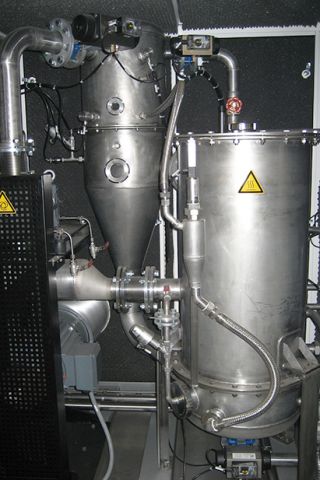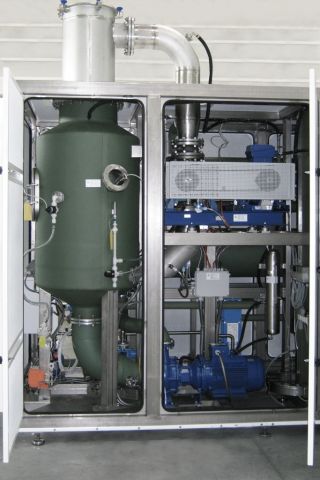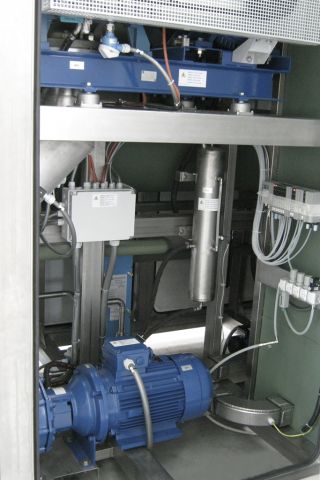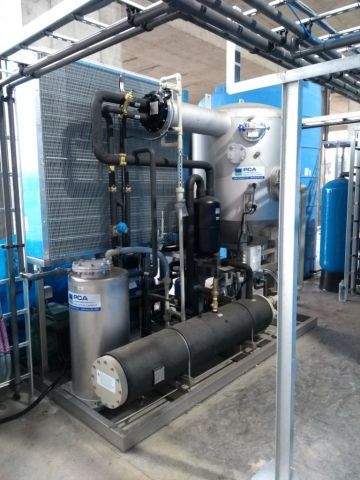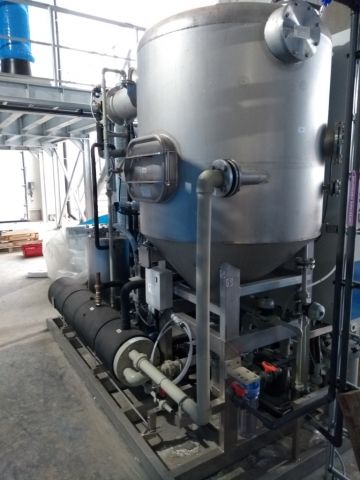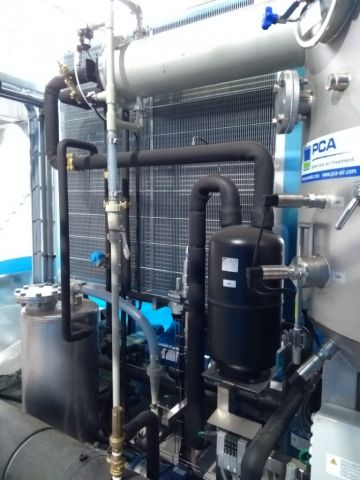Evaporator
Wastewater is purified and then reused in a closed cycle. That’s why evaporators are THE sustainable solution for the future!
What does an evaporator do?
In an evaporator the wastewater is evaporated. This vapour is then condensed again. The liquid that is obtained after the condensation is called 'distillate'. The pollution from the wastewater is highly concentrated and discharged as a liquid: 'the concentrate'. The distillate is almost always of a better quality than city water or rainwater. Depending on the wastewater to be treated, in some cases it can even produce demineralised water.
The concentrate flow can usually no longer be further purified and must therefore be discharged externally. In most cases this concentrate stream is 5 to 10% of the treated wastewater. About 90 to 95% of the incoming stream can be reused thanks to the evaporator.
High and low temperature evaporator
There are two large groups of evaporators: the high and the low temperature evaporators. They work in different ways, each with their own advantages and disadvantages.
| High temperature evaporators | Low temperature evaporators |
| Mechanical vapour compression system | Vacuum pump operating system |
| Operates at approx. 85 °C | Operates at approx. 35°C |
| Fairly low energy consumption (40 to 60 Wh/litre wastewater) | Higher energy consumption (approx. 140 Wh/litre wastewater) - multiple systems in series can significantly reduce electricity consumption |
| Slightly more sensitives to maintenance | Less sensitive to maintenance |
| More chance of corrosion | Less chance of corrosion |
| Usually for larger flows (>8000l/day) | Usually for smaller flows |
| Higher investment cost | Lower investment cost |
One-, two- or three-stage evaporator
Evaporators with a heat pump consume more of energy which means the operational is automatically higher. The impact is limited because there are usually lower flow rates. However, when it comes to larger flows you need a two- or three-stage evaporator.
With a two-stage evaporator, the incoming water will be divided into two equal streams. One stream is treated at a slightly higher temperature, after which the distillate from that stream is used to heat up the other stream. This way, only half of the water needs to be heated. This results in lower energy consumption and therefore lower operating costs.
For example, a two-stage evaporator uses 35% less energy than a single-stage evaporator.
The higher the flow rate, the more stages you can use.
Types of evaporator by materials
For both types of evaporators, you can choose between different materials. Concerning the materials which come into contact with the liquid, 3 types of materials can be used:
- Stainless steel 316L: the cheapest and most commonly used material, but also the most sensitive to pitting corrosion.
- Superduplex: affordable yet high resistance (much more resistant to chlorides and fluorides, which usually cause pitting corrosion).
- Hastelloy: most resistant to corrosion, but on the other hand very expensive.
As mentioned above, a low temperature evaporator is less susceptible to corrosion than a high temperature evaporator. This is simply because the fluorides and chlorides are much more aggressive at a higher temperature.
In special cases it is also possible to work with plastic evaporators. These evaporators are resistant to very corrosive materials. But this has to be evaluated case by case.
Types of evaporators based on heat exchanger
Besides the operating temperature and the material used, we can also subdivide on the basis of the heat exchanger:
- Forced circulation: The liquid is passed through the heat exchanger by a pump. As the fluid is pumped through the exchanger, the risk of charging is much lower and there will be less need for cleaning. This technology also ensures the best heat exchange.
- Natural circulation: The fluid flows through the heat exchanger only by natural force. This is much slower than forced circulation, resulting in much a much higher charge. That is why it will need to be cleaned more frequently.
- Scraper: When the liquid contains a lot of sludge, we recommend using a scraper. This ensures that the heat exchanger is scraped continuously, making cleaning rarely necessary.
- Inner coil: Here, the tubular heat exchanger is placed inside the boiler. This version is interesting for applications where there is little risk of charging.
Compact and autonomous
An evaporator is a device that can be considered as a backbox unit. It is supplied as a single unit and has its own electrical control and operation.
The capacity of a unit is expressed in hydraulic capacity per day (litres per day). An evaporator usually works autonomously 24 hours a day. Only a very limited manual follow-up is required.
When the unit is oversized, the process becomes less efficient. The evaporator will then only work a few hours a day and will require a considerable start-up time. During this start-up energy will be consumed, but no wastewater will be processed.
PCA can offer evaporators from 150 litres of water to be purified per day. On the other side of the spectrum there are no limits. The largest individual units purify up to 120 000 litres per day, but of course several units can be placed in parallel, allowing very large flows.
Energy supply to an evaporator
To evaporate water, the evaporator needs energy. In most cases electricity is used for this, as this is the easiest and always available source of energy.
Sometimes steam (or very hot water) is available. This can also be an interesting energy source for low temperature evaporators, especially when it comes to residual heat. Therefore, there must be a source of cooling water for the evaporator.
Cleaning of an evaporator
An evaporator works continuously and autonomously. Over time, however, a cleaning cycle of the installation will be required to ensure the proper functioning of the heat exchanger. Cleaning is usually automatic and does not require manual input. After cleaning, the cleaning fluids are added to the concentrate for disposal.
PCA usually uses evaporators where the liquid is pumped around by the heat exchanger. As a result, cleaning is only necessary every two weeks in most cases. Other types of evaporators often require cleaning cycles every other day or a day and a half. This gives a lot more waste.
Extra condensed concentrate
In larger plants, despite the strong condensing, a considerable amount of concentrate is still produced per day. However, there are also special evaporators with which this concentrate flow from the first evaporator can be further condensed. In this way, a serious volume reduction can be achieved.
Such a second step evaporator is usually equipped with an agitator in order to remove the vicious sludge from the unit.
Pre-treatment
When using an evaporator it is of course very important to check whether an evaporator is the appropriate solution. This requires the necessary expertise and experience. PCA has built up this knowledge over the years and can help you out.
We can also carry out a simulation on wastewater to determine which evaporator is best suited for the application.
If required, we can also provide pretreatments. This can range from simple neutralisation to more extensive processes.

